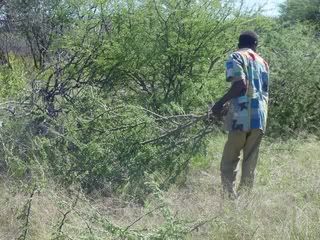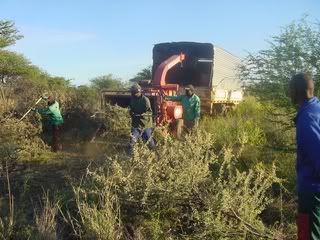Researchers: invasive bush biomass in Namibia has high energy production potential

There, the VTT Technical Research Centre of Finland, Northern Europe's largest contract science organisation, has studied the profitability of using bush chips in electricity production, where biomass from invasive bushes has great energy production potential. We referred earlier to a tentative study exploring this option, but now science backs up the preliminary findings (previous post).
Namibia suffers from the overgrowth of rapidly growing, robust bush, which is disruptive to cattle raising, the country's poor farmers' primary source of livelihoods, and threatens the survival of other plant species. The phenomenon of bush encroachment in Namibian savannas is regarded as part of the desertification process since the increase in the extent and density of woody vegetation occurs at the expense of other desirable grasses and forbs, resulting in an alarming reduction in productivity. The following definition of bush encroachment was accepted by rangeland experts in Namibia during a brainstorming session of the National Programme to Combat Desertification (NAPCOD):
Bush encroachment is the invasion and/or thickening of aggressive undesired woody species, resulting in an imbalance of the grass:bush ratio, a decrease in biodiversity, a decrease in carrying capacity and concomitant economic losses.VTT developed the production technology for the utilization of bush chips and looked at whether it can be applied in a cost-effective manner to tackle this environmental problem. Previous efforts to find ways of clearing the invader bush, such as massive herbicide spraying or burning campaigns, are hardly sustainable, cost-effective or environmentally friendly. Burning would result in large amounts of greenhouse gas emissions, whereas herbicides kill the ecosystem alltogether. Moreover, estimates show that it would cost up to N$5.2 billion (€534/US$714 million) to combat the infestation with these techniques. For a country like Namibia, this is a tall order. Individual, small farmers whose land is invaded say it is cheaper to buy a new farm than to try to eradicate the hardy bushes. (See the Bush Encroachment Research, Monitoring and Management project of the Ministry of the Environment).

VTT's trials with a mobile bush chipper, transforming the bulky biomass into chips that have a higher volumetric energy density. The biofuel is transported from the bush to a central briquetting plant.
According to the VTT, bioenergy could come to the rescue. It has been estimated that the overgrowth of bush greatly affects an area of about 10 million hectares in northern parts of central and eastern Namibia. There are between 1,000-10,000 bushes per hectare in this area. The amount of biomass per hectare ranges between 5-25 tonnes. The overgrowth of bush can be managed by thinning and leaving 200-300 of the largest bushes to grow on the savannah. An average quantity of biomass obtained by thinning is about 10 tonnes per hectare. The thinned bushes re-grow from their roots, and thinning can be repeated in 10-15 years. In other words, the area affected by the overgrowth of bush produces in total 125 million tonnes of biomass, i.e. 500 TWh. The total consumption of energy in Namibia was 12.6 TWh in 1999.The overgrowth of bush is harmful to, for example, cattle raising, as the bush reduces the growth of grass and it is almost impossible to move in thick bush. The production of bioelectricity would contribute to Namibia’s energy self-sufficiency, which is currently low. Namibia imports most of its electricity from South Africa. There is a coal-fired power plant in the country’s capital, Windhoek, but it is used sporadically to supplement imported South African electricity. At the moment, the bush is used for firewood (about 1 million tonnes a year) and for charcoal production (0.3 million tonnes a year). Namibia also has one briquette factory, which produces about 6,000 tonnes of briquettes from bush chips.
The VTT actually trialed bush chip production for its study to look at its commercial viability. The tests were carried out on a farm owned by the CCF (Cheetah Conservation Fund). The farm is 36,000 hectares in size and is located in the area where bush growth is a problem, i.e. about 200 km north of Windhoek. Chips for the briquette factory owned by the CCF are produced on the farm:
 energy :: sustainability :: biomass :: bioenergy :: biofuels :: bio-electricity :: biomass briquettes :: supply chain :: invasive species :: biodiversity :: conservation :: energy security :: poverty alleviation :: Namibia ::
energy :: sustainability :: biomass :: bioenergy :: biofuels :: bio-electricity :: biomass briquettes :: supply chain :: invasive species :: biodiversity :: conservation :: energy security :: poverty alleviation :: Namibia :: In the CCF chip production process, the bushes are cut by axe. After cutting, the bushes are carried to the side of the skid road. The skid roads are 50 metres apart. The bushes are placed in piles by the skid road, where they are dried to 15-20% moisture content. In Namibian weather conditions, it takes two to three weeks of drying for the bush to achieve this moisture content. When the bush is sufficiently dry, it is chipped in a drum chipper. The chipper blows the chips straight into a tractor trailer, which takes them to the briquette factory 40 km away. Two trailers equipped with tipping gear are attached to the tractor.
The cutting trials were carried out on one-hectare test plots. Thirteen plots were used for the study. After thinning, 200-250 bushes remained in the cutting area. The average yield in the test plots was 7 tonnes per hectare. In the cutting tests, the productivity of the various work stages was measured in tonnes per time unit. The productivity of cutting was 0.25 ha (1.7 tons) and of transport 0.30 ha (2.0 tons) per worker per day. The productivity of chipping was 20.1 tonnes per day and of road transport 10.5 tonnes per day, when the transportation distance was 50 km.
The bioplant of 5 MW under review uses 32,000 tonnes of chips per year at a moisture content of 20%. To produce this amount using the existing production chain requires 198 men, in addition to the machines. The production cost of the chips, calculated for a transport distance of 30 km, is €5.1/MWh. Chipping costs are the largest individual cost item.
Costs reduced by 15%
VTT also improved the efficiency of the chip production chain. Based on machinery tests, it was proposed that the chain be fully mechanised. In the mechanised chain, bushes are cut with a small tractor equipped with a rotating cutting head. The bushes are moved by a small tractor equipped with a grapple. The chipping is done by a drum chipper equipped with a feeder, and a tractor-trailer combination is used for road transport due to the short distance. According to VTT, the new mechanised chain could reduce the cutting costs by about 15%, in comparison with the chain used at the moment. If a 50 MW electricity plant uses 32,000 tonnes of chips (at a 20% moisture content) per year, 32 workers are needed for the production.
Electricity production in separate 10 MW and 20 MW plants is profitable if the investor investing in the plant receives 35% investment aid and €15 per tonne of carbon dioxide in emissions trading. According to the study, a 20 MW plant would repay itself in seven years and a 10 MW plant in 10 years. In the study, the price of electricity was €40/MWh. A 5 MW plant is too small, which is why the repayment period for it using the values provided above, is 16 years. The plants could be located in northern Namibia where the largest biomass resources are located.
There is a coal-fired power plant with four boilers in Windhoek. In the project, the conversion of one of these to biomass was considered. The boiler’s capacity using biomass would be 20 MW, which is somewhat less than when coal is used. The conversion of the boiler to biomass would be profitable even without aid. Electricity production costs would be €35.6/ MWh. Most of the costs would be incurred by fuel (€27/MWh). The capital cost would be €5.5/MWh. The investment would repay itself in seven years.
VTT Technical Research Centre of Finland is the biggest contract research organisation in Northern Europe. VTT provides high-end technology solutions and innovation services. From its wide knowledge base, VTT can combine different technologies, create new innovations and a substantial range of world class technologies and applied research services thus improving its clients' competitiveness and competence. Through its international scientific and technology network, VTT can produce information, upgrade technology knowledge, create business intelligence and value added to its stakeholders. VTT is a non-profit-making research organisation.
Images: studying the bush biomass supply chain in the field. Credit: VTT.
References:
Leinonen, A. Wood chip production technology and costs for fuel in Namibia. Espoo 2007. VTT Tiedotteita – Research Notes 2417. 66 p. +app. 21 p.
VTT: VTT studied the profitability of electricity production with bush chips in Namibia - January 14, 2008.
AlphaGalileo: Bush biomass has high energy production potential - January 14, 2008.
Biopact: Namibia to use invasive shrubs for bioenergy, to meet all power needs - April 02, 2007
Ministry of Environment and Tourism: Bush Encroachment - Report on Phase 1 of the Bush Encroachment Research, Monitoring and Management Project.
The Namibian (via AllAfrica): Namibia: N$5.2 Billion Needed for Bush Clearing - March 12, 2007.
New Era (Windhoek) (via AllAfrica): There's Power in the Bush - April 2, 2007.
 --------------
--------------
 Record warm summers cause extreme ice melt in Greenland: an international team of scientists, led by Dr Edward Hanna at the University of Sheffield, has found that recent warm summers have caused the most extreme Greenland ice melting in 50 years. The new research provides further evidence of a key impact of global warming and helps scientists place recent satellite observations of Greenland´s shrinking ice mass in a longer-term climatic context. Findings are published in the 15 January 2008 issue of Journal of Climate.
Record warm summers cause extreme ice melt in Greenland: an international team of scientists, led by Dr Edward Hanna at the University of Sheffield, has found that recent warm summers have caused the most extreme Greenland ice melting in 50 years. The new research provides further evidence of a key impact of global warming and helps scientists place recent satellite observations of Greenland´s shrinking ice mass in a longer-term climatic context. Findings are published in the 15 January 2008 issue of Journal of Climate.








0 Comments:
Post a Comment
Links to this post:
Create a Link
<< Home